Related Research Articles

The Gospel of James is a second-century infancy gospel telling of the miraculous conception of the Virgin Mary, her upbringing and marriage to Joseph, the journey of the couple to Bethlehem, the birth of Jesus, and events immediately following. It is the earliest surviving assertion of the perpetual virginity of Mary, meaning her virginity not just prior to the birth of Jesus, but during and afterwards, and despite being condemned by Pope Innocent I in 405 and rejected by the Gelasian Decree around 500, became a widely influential source for Mariology.

John the Evangelist is the name traditionally given to the author of the Gospel of John. Christians have traditionally identified him with John the Apostle, John of Patmos, and John the Presbyter, although this has been disputed by most modern scholars.
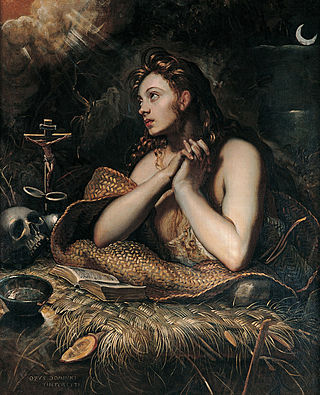
Mary Magdalene was a woman who, according to the four canonical gospels, traveled with Jesus as one of his followers and was a witness to his crucifixion and resurrection. She is mentioned by name twelve times in the canonical gospels, more than most of the apostles and more than any other woman in the gospels, other than Jesus's family. Mary's epithet Magdalene may be a toponymic surname, meaning that she came from the town of Magdala, a fishing town on the western shore of the Sea of Galilee in Roman Judea.
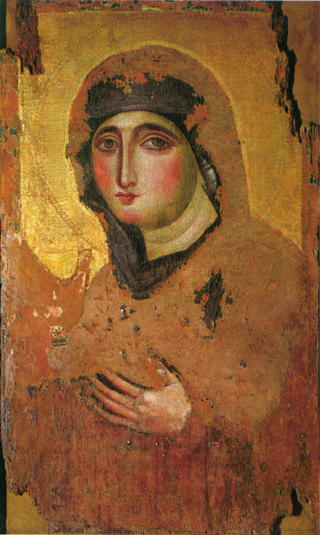
Mary was a first-century Jewish woman of Nazareth, the wife of Joseph and the mother of Jesus. She is a central figure of Christianity, venerated under various titles such as virgin or queen, many of them mentioned in the Litany of Loreto. The Eastern and Oriental Orthodox, Church of the East, Catholic, Anglican, and Lutheran churches believe that Mary, as mother of Jesus, is the Mother of God. Other Protestant views on Mary vary, with some holding her to have lesser status.

In art, a Madonna is a representation of Mary, either alone or with her child Jesus. These images are central icons for both the Catholic and Orthodox churches. The word is from Italian ma donna 'my lady' (archaic). The Madonna and Child type is very prevalent in Christian iconography, divided into many traditional subtypes especially in Eastern Orthodox iconography, often known after the location of a notable icon of the type, such as the Theotokos of Vladimir, Agiosoritissa, Blachernitissa, etc., or descriptive of the depicted posture, as in Hodegetria, Eleusa, etc.

Balthild, also spelled Bathilda, Bauthieult or Baudour, was queen consort of Neustria and Burgundy by marriage to Clovis II, the King of Neustria and Burgundy (639–658), and regent during the minority of her son, Chlothar III. Her hagiography was intended to further her successful candidature for sainthood.
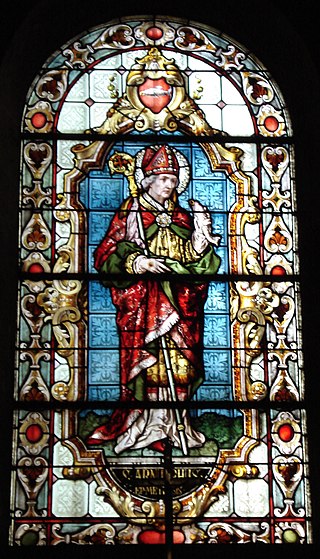
Arnulf of Metz was a Frankish bishop of Metz and advisor to the Merovingian court of Austrasia. He later retired to the Abbey of Remiremont. In French he is also known as Arnoul or Arnoulf. In English he is known as Arnold.

Paschasius Radbertus (785–865) was a Carolingian theologian and the abbot of Corbie, a monastery in Picardy founded in 657 or 660 by the queen regent Bathilde with a founding community of monks from Luxeuil Abbey. His most well-known and influential work is an exposition on the nature of the Eucharist written around 831, entitled De Corpore et Sanguine Domini. He was canonized in 1073 by Pope Gregory VII. His feast day is April 26. His works are edited in Patrologia Latina vol. 120 (1852) and his important tract on the Eucharist and transubstantiation, De Corpore et Sanguine Domini, in a 1969 edition by B. Paulus, published by Brepols.
Caroline Walker Bynum, FBA is a Medieval scholar from the United States. She is a University Professor emerita at Columbia University and Professor emerita of Western Medieval History at the Institute for Advanced Study in Princeton, New Jersey. She was the first woman to be appointed University Professor at Columbia. She is former Dean of Columbia's School of General Studies, served as president of the American Historical Association in 1996, and President of the Medieval Academy of America in 1997–1998.

The Three Marys are women mentioned in the canonical gospels' narratives of the crucifixion and resurrection of Jesus. Mary was the most common name for Jewish women of the period.
Glodesind (572−608) was a saint, nun, abbess, and founder of a convent in Metz, France, during the time of King Childebert II (575−596) of Austrasia. She was a member of the Carolingian nobility. When she was 11 or 12 years old, she married a young nobleman, who was arrested by the French government shortly after their wedding and executed a year later. Instead of remarrying as her family wanted, she fled to Metz and took refuge at the Church of St. Stephen. Her family gave up forcing her to marry, and she became a nun and later, the abbess of a convent that was built by her parents. She was abbess for six years until her death in 608 at the age of 30. Her feast day is 8 July.
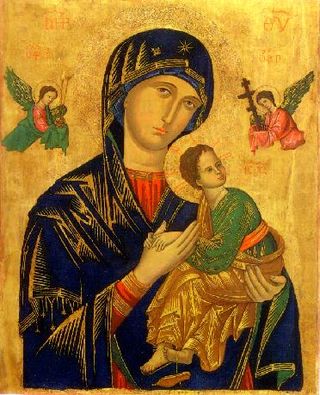
Mary has been one of the major subjects of Western art for centuries. There is an enormous quantity of Marian art in the Catholic Church, covering both devotional subjects such as the Virgin and Child and a range of narrative subjects from the Life of the Virgin, often arranged in cycles. Most medieval painters, and from the Reformation to about 1800 most from Catholic countries, have produced works, including old masters such as Michelangelo and Botticelli.
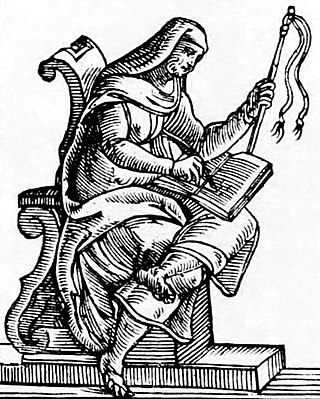
Agnes Blannbekin was an Austrian Beguine and Christian mystic. She was also referred to as Saint Agnes Blannbekin or the Venerable Agnes Blannbekin, though never beatified or canonized by the Roman Catholic Church. Her revelations were compiled by an anonymous confessor before being transcribed by the monk Ermenrich and later published in 1731 as Venerabilis Agnetis Blannbekin. The copies were confiscated by the Society of Jesus, and only two manuscripts survived. One was destroyed in a fire at the Strasbourg library in 1870. The surviving manuscript, currently owned by a Cistercian convent in Zwettl, Austria, was not released until the 20th century. Although Blannbekin is best remembered today for her visions, during her life she was known for her ministry to the urban population and her strange and provocative expressions of faith.
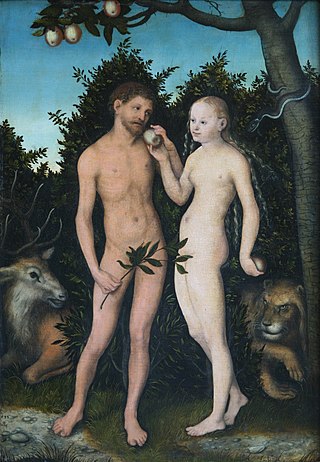
Women play significant roles in the life of the Catholic Church, although excluded from the Catholic hierarchy of bishops, priests, and deacons. In the history of the Catholic Church, the church often influenced social attitudes toward women. Influential Catholic women have included theologians, abbesses, monarchs, missionaries, mystics, martyrs, scientists, nurses, hospital administrators, educationalists, religious sisters, Doctors of the Church, and canonised saints. Women constitute the majority of members of consecrated life in the Catholic Church: in 2010, there were around 721,935 professed women religious. Motherhood and family are given an exalted status in Catholicism, with The Blessed Virgin Mary holding a special place of veneration.
Eustadiola (594–684) was a saint, widow, and abbess. She was born to wealthy and politically powerful parents in Bourges, France. She married due to pressure from her family, but became a widow at a young age, which gave her the financial and social independence to live what Sainted Women of the Dark Ages centuries later called a "semiretired religious life". She gave away her wealth to the poor, founded churches, monasteries, and convents, and used her wealth and influence to expand and decorate the buildings. Eustadiola was abbess of the convent she founded in Bourges, and lived as an ascetic for 70 years. Many miracles and healings were attributed to her. Her feast day is celebrated on 8 June.

Desert Mothers is a neologism, coined in feminist theology as an analogy to Desert Fathers, for the ammas or female Christian ascetics living in the desert of Egypt, Palestine, and Syria in the 4th and 5th centuries AD. They typically lived in the monastic communities that began forming during that time, though sometimes they lived as hermits. Monastic communities acted collectively with limited outside relations with lay people. Some ascetics chose to venture into isolated locations to restrict relations with others, deepen spiritual connection, and other ascetic purposes. Other women from that era who influenced the early ascetic or monastic tradition while living outside the desert are also described as Desert Mothers.
Saint Liutberga, also called Liutbirg and Liutbirga, was an influential nun in Saxony in the 9th century, who ended her life as an anchoress in Windenhausen. Her life provides important evidence for female experiences of religion in the ninth-century Carolingian Empire, and also gives some insight into the background of Ottonian convents like Gandersheim and Quedlinburg. A ninth-century saint, Liutberga, provided an unexpected new model of holiness, that of the executive housekeeper. St. Liutberga's feast is February 28.

Affective piety is most commonly described as a style of highly emotional devotion to the humanity of Jesus, particularly in his infancy and his death, and to the joys and sorrows of the Virgin Mary. It was a major influence on many varieties of devotional literature in late-medieval Europe, both in Latin and in the vernaculars. This practice of prayer, reading, and meditation was often cultivated through visualization and concentration on vivid images of scenes from the Bible, Saints' Lives, Virgin Mary, Christ and religious symbols, feeling from the result. These images could be either conjured up in people's minds when they read or heard poetry and other pieces of religious literature, or they could gaze on manuscript illuminations and other pieces of art as they prayed and meditated on the scenes depicted. In either case, this style of affective meditation asked the "viewer" to engage with the scene as if she or he were physically present and to stir up feelings of love, fear, grief, and/or repentance for sin.
Amanda was an aristocratic, religious woman in the late Antique period, known for her letter-exchanges; her dates of birth and death are unknown, but are possibly between the late fourth to the early fifth century.
Although Merovingian Francia is not considered a slave society, slaves were, nonetheless, present throughout the entirety of the dynasty and well into the Carolingian period and beyond. In the 7th century, however, the sale and trade of Christians within Frankish borders was abolished by Queen Balthild, herself a former slave.
References
- 1 2 Bynum, Caroline Walker (1984). Jesus as Mother: Studies in the Spirituality of the High Middle Ages. U of California P. p. 139. ISBN 9780520052222 . Retrieved 7 April 2016.
- ↑ Neusner, Jacob (1993). Androgynous Judaism: masculine and feminine in the dual Torah. Mercer UP. p. 155. ISBN 9780865544284.
- 1 2 Schnapp, Jeffrey T. "Dante's Sexual Solecisms: Gender and Genre in the Commedia". In Marina S. Brownlee; Kevin Brownlee; Stephen G. Nichols (eds.). The New Medievalism (PDF). Baltimore: Johns Hopkins UP. pp. 201–25.
- ↑ McNamara, Jo Ann (1976). "Sexual Equality and the Cult of Virginity in Early Christian Thought". Feminist Studies . 3 (3/4): 145–58. doi:10.2307/3177733. JSTOR 3177733.